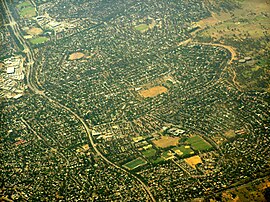Weetangera, Australian Capital Territory
|
Weetangera Canberra, Australian Capital Territory |
|||||||||||||
|---|---|---|---|---|---|---|---|---|---|---|---|---|---|

Weetangera is in the centre of this aerial photo.
|
|||||||||||||

Weetangera, shaded in pink.
|
|||||||||||||
| Coordinates | 35°15′00″S 149°02′56″E / 35.250°S 149.049°ECoordinates: 35°15′00″S 149°02′56″E / 35.250°S 149.049°E | ||||||||||||
| Population | 2,608 (2011 census) | ||||||||||||
| • Density | 1,630/km2 (4,220/sq mi) | ||||||||||||
| Gazetted | 22 August 1968 | ||||||||||||
| Postcode(s) | 2614 | ||||||||||||
| Area | 1.6 km2 (0.6 sq mi) | ||||||||||||
| District | Belconnen | ||||||||||||
| Territory electorate(s) | Ginninderra | ||||||||||||
| Federal Division(s) | Fenner | ||||||||||||
|
|||||||||||||
Weetangera is a suburb in the Belconnen district of Canberra, located within the Australian Capital Territory, Australia. The suburb covers an area of approximately 158 hectares (390 acres). Located approximately 10 kilometres (6.2 mi) north-west of the city, Weetangera is bounded by Springvale Drive to the south and west, Coulter Drive to the east and Belconnen Way to the north. The Pinnacle Nature Reserve, a Canberra Nature Park is adjacent to the south of the suburb, across Springvale Drive.
Europeans first settled the area in the 1800s, and it was named Weetangera after the property "Spring Vale", which in turn had been given a name of Aboriginal origin (it is also called Weetangerra and Weetangara in early documents). A school was first built in the area in 1875.
The modern suburb of Weetangera was officially gazetted by the ACT Government in 1968, with a street theme: 'Pioneers of the Australian Capital Territory'. After the gazetting, the first modern settlers moved into the suburb in 1970 and the first students moved into the Weetangera Primary School, located about a kilometre from the old Weetangera Primary School, in 1973. Today, the suburb is home to over 2500 people.
Weetangera is named after the property "Spring Vale", which in turn had been given a name of Aboriginal origin, due to a spring near the site of the original Public School called "Wittanjirra" in the local Aboriginal dialect, meaning "to suck, to drink greedily".Samuel Shumack lived at "Spring Vale" between 1866 and 1915. Shumack and his father had taken up the land for farming when Samuel was eight years old. Samuel Shumack lived on the property with his family until it was claimed as land for the nation's capital in 1915.
Weetangera was also the name for the Weetangera parish, which included the land from Ginninderra Creek to the Molonglo River. The Southwell family were significant to this property, and various members of the family are buried in the Weetangera Cemetery and former Methodist Church now sited to the west of the adjoining suburb, Hawker.
...
Wikipedia
